Philips Electronics Singapore RC1534542 Bluetooth Remote User Manual RC1534542 01BX
Philips Electronics Singapore Pte Ltd Bluetooth Remote RC1534542 01BX
User Manual Draft 2
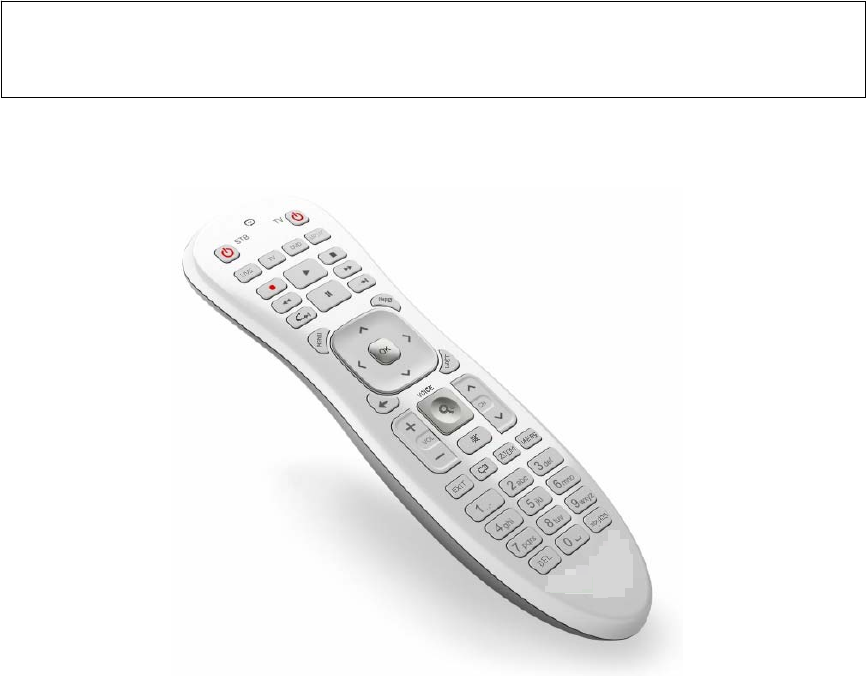
DocID:
Date: 2012-05-24
Version: 0.1
Status:
Model: Draft
RC1534542/01B
Remote Control User Manual

Confidential Remote Control User Manual
2/16 0.1, RC1534542/01B
DRAF
T
Table of contents
1.Battery Installation 3
2.Remote Features Overview 4
3.Database Function & Learn Function 5
3.1The Database key table 5
3.2 Set-up Mode 5
3.3 General 6
3.4 Set Features for Learn 7
4.Bluetooth Functions 錯誤! 尚未定義書籤。
4.1STB Bluetooth Pairing 8
4.2 BT Pairing (Out-of-the-Box/ Replacement Remote) 8
4.3 BT Pairing (Replacement of Mediabox/ BT Link failed to reconnect) 9
5.Voice Functions 11
5.1BT Wireless Audio Link 11
6. Factory Reset 12
7. Battery Low Power Handling & Indication 13
8.Certification Information 15
9. FCC Statement 15
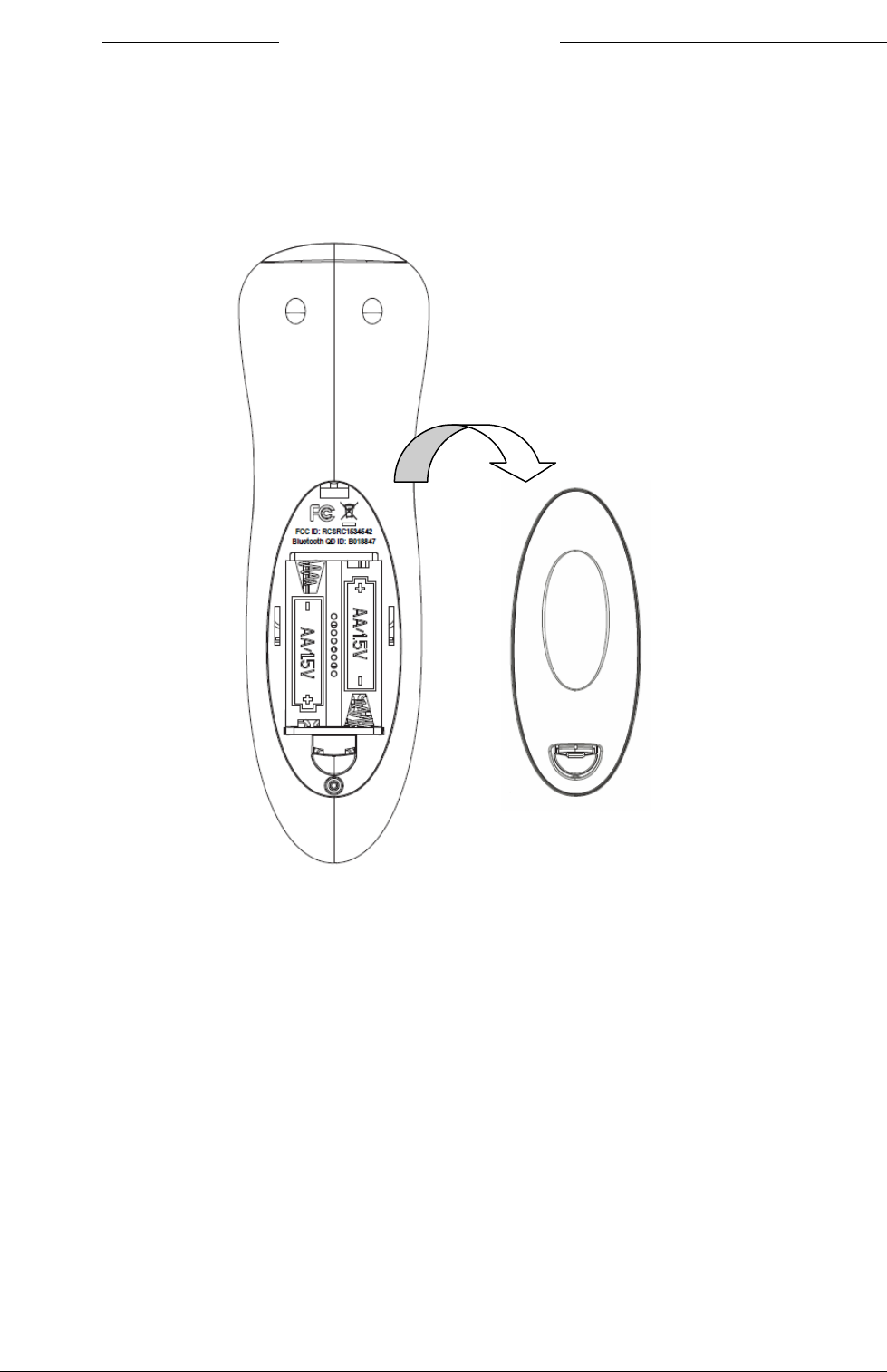
Confidential Remote Control User Manual
3/16 0.1, RC1534542/01B
DRAF
T
1. Battery Installation
Battery installation
Open battery cover at bottom side of remote control. Insert 2 x AA batteries.
Ensure batteries are properly installed. Install back the battery cover. The remote
control is ready to be used.
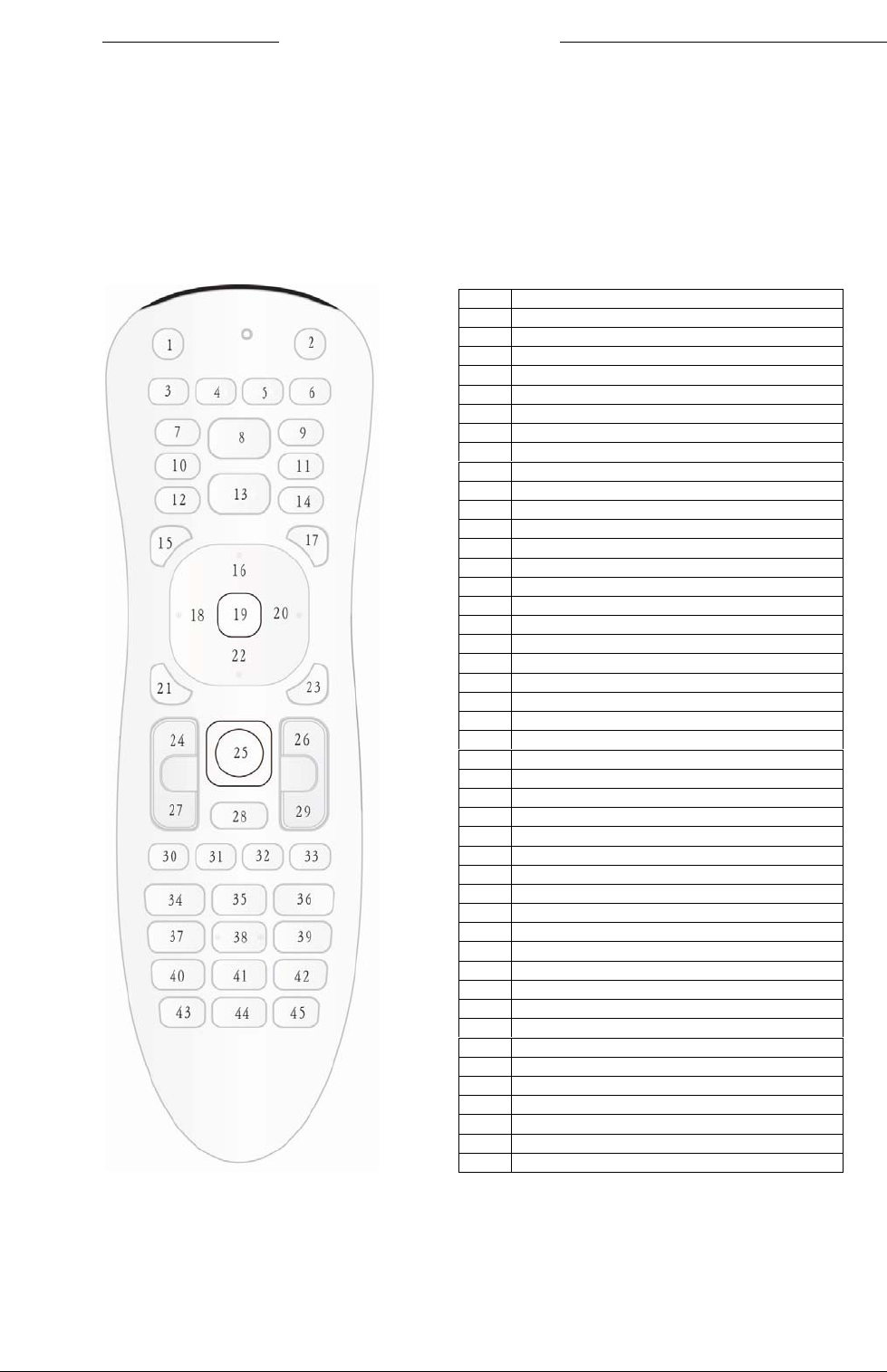
Confidential Remote Control User Manual
4/16 0.1, RC1534542/01B
DRAF
T
2. Remote Features Overview
Remote control functions
KeyFunctions
1PowerOn/Off‐STB
2PowerOn/Off‐TV
3Live‐gotoLiveTVmode
4Guide
5DigitalVideoRecorder
6Input‐selectinputsourcesonTV
7Record
8Play
9Stop
10 Rewind
11 FastForward
12 SkipBackward
13 Pause
14 SkipForward
15 Menu
16 Info
17 Up
18 Left
19 OK
20 Right
21 Down
22 Back
23 Last
24 VolumeUp
25 VolumeDown
26 VOICESearch
27 ChannelUp
28 ChannelDown
29 Mute
30 Exit
31 Telepresense‐VideoConference
32 Zoom
33 Views‐Switchviewsbetweeniconsandlist
34 Numerickey1
35 Numerickey2
36 Numerickey3
37 Numerickey4
38 Numerickey5
39 Numerickey6
40 Numerickey7
41 Numerickey8
42 Numerickey9
43 Delete
44 Numerickey0
45 abc/123‐Togglebetweennumbersandalphabets

Confidential Remote Control User Manual
5/16 0.1, RC1534542/01B
DRAF
T
3. Database Function & Learn Function
3.1 The Database key table
The RC has Database for TV device. The keys supporting the Database are described as below.
All the other keys will act the same as the remote control in STB mode.
Key Number Key Name TV
2 TV_POWER YES
6 INPUT YES
24 VOL+ YES
25 VOL- YES
29 MUTE YES
YES: This key is available in the current mode.
3.2 Set-up Mode
All Set-up mode features are meant to change the settings of the remote. Each
feature is triggered by a special key-press. An overview of the Set-up features
and the corresponding keypress is shown in the table below.
Set-up feature Description Initiating key-combination
Brand Search
Brand Search is the main
way to program the remote
to control the devices. Using
the Universal IRDB.
Inactivity timeout: 300s.
<<TV Power + OK>>
Auto-Search
Entering 9999 the remote
can search for IR-codes in
the full IRDB.
Inactivity timeout: 300s.
<<TV Power + OK>>
Manual codeset
entry setup
Allows direct entry of a
Codeset-id to program the
remote.
This is meant mainly for
support.
<<1+3>>

Confidential Remote Control User Manual
6/16 0.1, RC1534542/01B
DRAF
T
Set-up feature Description Initiating key-combination
Inactivity timeout: 300s.
Key Fix
Allows the user to fix keys
that still don’t work after a
Brand-search.
Inactivity timeout: 300s.
One: <<TV Power + OK>>
Two: <<1+4>>
Learn Learn other remote keys
Inactivity timeout: 30s
<<1+5>>, <learnable key>, <OK>
Notation: <> normal key press,
<< >> press this key or these keys for 3 seconds.
3.3 General
When the user starts a Setup-feature, the LED of corresponding device turns on
to indicate this.
a) In setup mode, in order to indicate a valid key press sequence, the LED will
do a Confirmation blink.
If the remote stays in Setup-mode the LED turns on again. If the remote
returns to use-mode, the LED turns off.
b) In case of an Invalid key press sequence, the device LED will do an Error
blink.
If the remote stays in Setup-mode the LED turns on again. If the remote
returns to use-mode, the LED turns off.
c) When RC returns to use-mode from Setup-mode, all device LEDs are turned
off, optionally by a confirmation or error blink sequence.
d) In set-up mode, after each key press, the user has some time to press the
next key. This is the inactivity timeout period. For some set-up features this
timeout can be different. If no key is pressed within a timeout period the LED
displays an error blink and turns off. The RC goes to use-mode.

Confidential Remote Control User Manual
7/16 0.1, RC1534542/01B
DRAF
T
3.4 Set Features for Learn
The RC also supports learn function for TV_POWER, INPUT, VOL+, VOL- and MUTE keys in TV
mode.
Feature Key sequence
Learn <<1+5>>, <learnable key>, <OK>
Learnable key: TV_POWER, INPUT, VOL+, VOL- and MUTE.
The procedure is as following.
1. Press the TV Power key to switch the RC to TV mode.
2. Press Digit 1 and Digit 5 simultaneously for 3 seconds. During the initial 3 seconds,
the LEDs will remain off. After 3 seconds the LED will give a confirmation blink and
then keeps on. Release the Digit 1 and Digit 5 at the same time after 3 seconds.
3. Press a learnable key, the LED will turn off when the learnable key is pressed. And
then release the learnable key, the LED will turn on.
4. Hold the source remote (in of sight) at an optimum distance (3cm to 6cm) and
continuously transmit the signal by pressing the key from source remote that you want
to learn into the RC.
5. The LED gives 2 reverse blinks if learning is successful and the new learnt codes will
replace the previous one. The LED will still be on to wait for the next learning key.
The LED will give 4 reverse blinks if the learning is failed, go back to step 3 to learn
this key again. The previous key code is kept.
6. User can learn other keys by following step 3 to 5.
7. Press the OK key to confirm the learnt codes and exit to the use-mode. After pressing
the OK key, the LED will give a confirmation blink.
Notes:
If no key is pressed within 30s after enter into the learn setup mode, the RC will
return to use-mode with an error blink to indicate time out.
If no signal for the RC to learn within 30s after pressing a learnable key, the RC will
return to use-mode with an error blink to indicate time out.
If the learnable key has been pressed for 30s, the RC will enter into Stuck Key
Time-out.

Confidential Remote Control User Manual
8/16 0.1, RC1534542/01B
DRAF
T

Confidential Remote Control User Manual
9/16 0.1, RC1534542/01B
DRAF
T
4. Bluetooth functions
4.1 STB Bluetooth Pairing
BT Pairing of remote with Mediabox will take place in following 3 situations:
when remote and Mediabox are out of the box and install for the 1st time
when existing remote is lost or broken and a new replacement remote is
added
when Mediabox is being replaced or reset, and added to work with
existing remote
BT pairing under above situation will only happen when both remote and
Mediabox are within 2m proximity
The remote control interacts with Mediabox UI via IR, or BT.
By factory default or after a master reset, the remote control does not contain any BT pairing
information. The Remote will default to be in STB Mode. The Remote will send STB IR Code.
In BT mode, the STB Power key will start to use RF until the BT link is “virtual cable unplug”
(either due to Mediabox out of range or Mediabox is off or Mediabox is being replaced). BT
pairing is described in more detail at section BT Pairing.
Each remote control should pair with 1 Mediabox (although technically
can pair with up to 4 boxes). When trying to pair a previously paired remote to a
Mediabox, the previously paired information will be replaced on both the
Mediabox and Remote control.
Before pairing, the STB Power key will only send IR code. After Pairing the STB
power key will send both IR and BT.
4.2 BT Pairing (Out-of-the-box / Replacement Remote)
When the batteries are inserted for the first time, the RC is not paired to any
Mediabox. To start pairing, the following procedure applies.
1) If any key is pressed in STB mode (except <Voice>, <TV Power> and
<Input>), the STB IR codes will be sent. When there are no key presses
for more than 1sec, the Remote will starts the Pairing Process.
2) The remote starts the pairing process by sending an IR Pairing Code to
the MediaBox according to IR Format in Section 4.12.1

Confidential Remote Control User Manual
10/16 0.1, RC1534542/01B
DRAF
T
3) If the key press is the STB Power key, the Remote will send the STB
Power key IR code. When the STB Power key is released, the Remote
will then send the IR Pairing code.
4) When the BD Address is verified, the Mediabox will start the pairing
process.
5) If the pairing fails, the Remote will goes to sleep mode.
6) If the pairing is ok, the STB will then send a DeviceID (using RF) to the
RC. The RC can now control this MediaBox only.
7) Subsequently, when the STB Power key is pressed, the IR code will
contain the Device ID and Command Code information (See 4.12.3 STB
RC6 Code Format).
8) The remote control pairing will timeout after 3mins. After 3 mins, the RC
will goes to sleep mode. The RC will remain in an “unpaired” state.
4.3 BT Pairing (Replacement of Mediabox / BT Link failed to
reconnect)
1. The RC needs to be setup again in order to work with a new Mediabox, or
a previous BT link is “virtual cable unplugged”.
2. The user will need to press “OK” and Digit “2” key simultaneously to start
the pairing process manually as below.
3. The remote starts the pairing process by sending an IR Code to the
MediaBox according to IR Format in Section 4.12.1
4. The Mediabox must check and confirm the data are correct with the
Checksum.
5. When the BD Address is verified, the Mediabox will then start the pairing
process.
6. If the pairing fails, the Remote will goes to sleep mode.

Confidential Remote Control User Manual
11/16 0.1, RC1534542/01B
DRAF
T
7. If the pairing is ok, the STB will then send a DeviceID (using RF) to the
RC. The RC can now control this MediaBox only.
8. Subsequently, when the STB Power Key is pressed, the IR code will
contain the Device ID and IR Command Code information (See 4.12.2
STB IR Code Format).
9. The remote control pairing will timeout after 3mins. After 3min, the RC
will goes to sleep mode. The RC will remain in the “unpaired” state.
*Note :
After pairing, the STB keys will send BT only. Only the STB Power key will
send IR and BT.
In TV Mode, only the 5 TV keys (TV Power, Input, Mute, Vol+, Vol-) will send
IR.
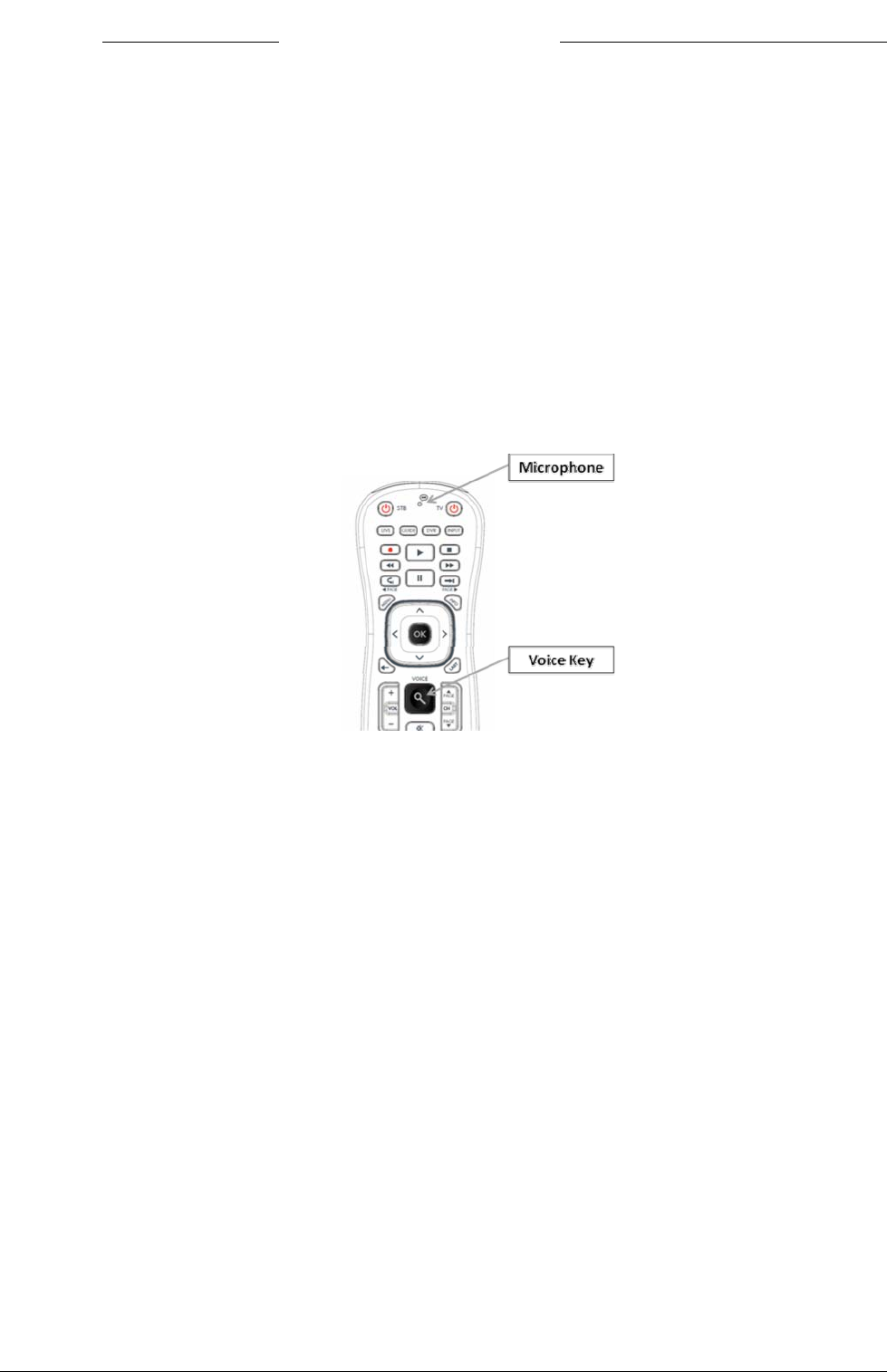
Confidential Remote Control User Manual
12/16 0.1, RC1534542/01B
DRAF
T
5. Voice functions
5.1 BT Wireless Audio Link
The remote control can capture audio (mainly for human voice) at 16bits, 16KHz sampling rate
in uncompressed digital format and transmit over BT wireless audio link.
When VOICE button is pressed and hold, the microphone and the BT wireless
audio link will be enabled, at the same time a BT Command will be sent to inform
the Mediabox. This allows the user to speak phrases of commands to the
microphone port of the remote control. Upon pressing of VOICE button, it may
take up to 0.3 sec for the wireless audio link to be ready.
To use the voice feature :
1. Press and hold the “VOICE” Button.
2. The RC will send a BT command to the MediaBox.
3. Speak into the MIC near the top of the remote control.
4. Release the “VOICE” Button after speaking the message.
5. The RC will send a BT command to indicate the end of the voice message.
6. The RC remains in standby mode for 5secs before going to sleep mode.
7. Alternatively, a quick Tap on the Voice key (Quick press and release) will
also enable the VOICE feature. To end the VOICE feature, do another
quick Tap on the Voice key.

Confidential Remote Control User Manual
13/16 0.1, RC1534542/01B
DRAF
T
6. Factory Reset
Pressing the key “DEL” and “STB” together for 3 sec will erase the BT pairing
information. The LED under STB Power key will blink twice to indicate successful
reset.
Pressing the key “DEL” and “TV” together for 3 sec will erase all learn data,
keyfix and Database codeset. The LED under TV Power key will blink twice to
indicate successful reset.
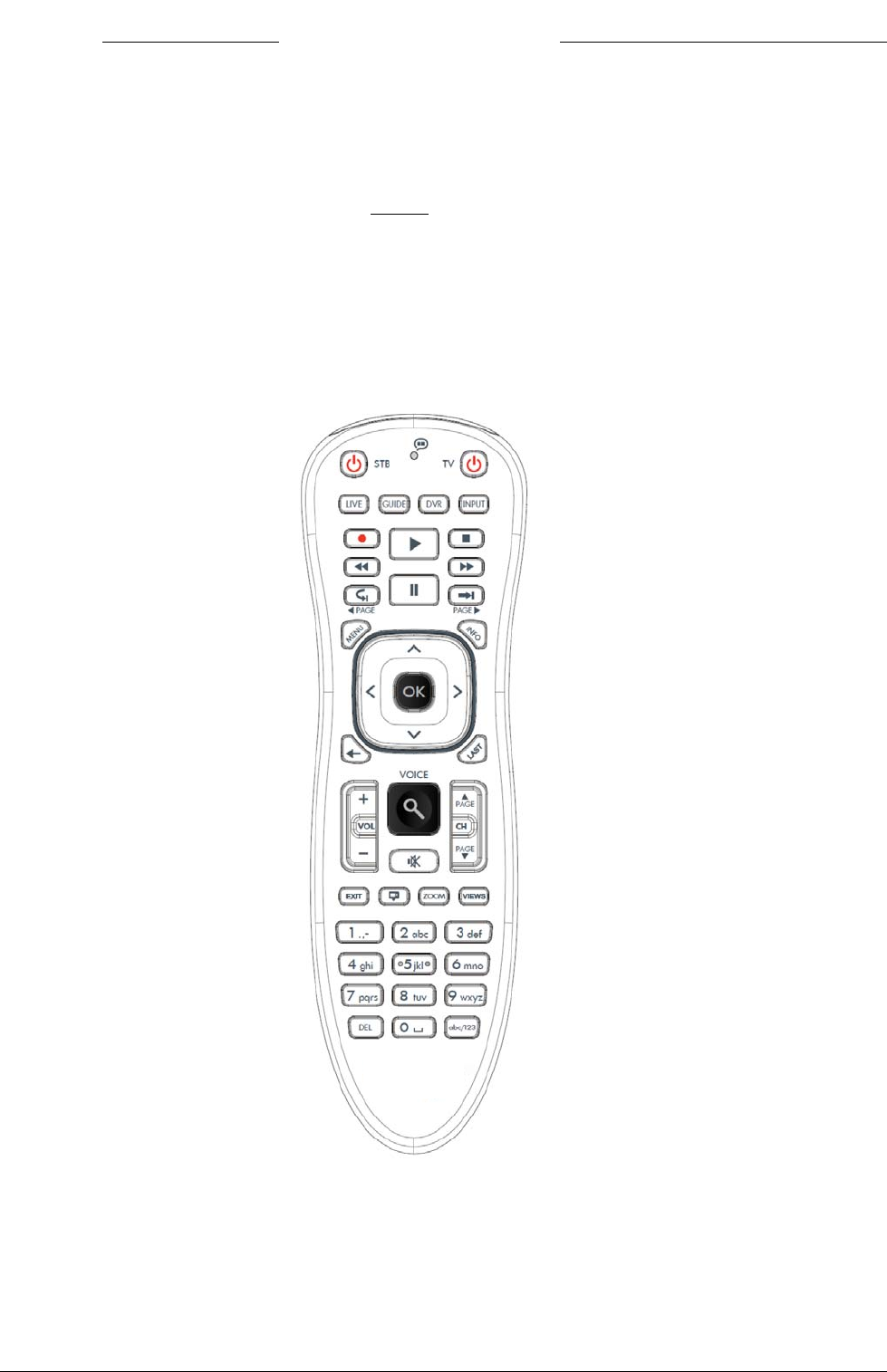
Confidential Remote Control User Manual
14/16 0.1, RC1534542/01B
DRAF
T
7. Battery low power handling & indication
When the remote control is in use, and if the battery voltage level is at low level,
and after each key press is released, both the STB & TV LEDs will blink to
indicate battery low.
During battery low condition, all functions are usable, except following task will
not be possible: learn other remote, pairing and soft reset
Users are required to replace new batteries as soon as possible.

Confidential Remote Control User Manual
15/16 0.1, RC1534542/01B
DRAF
T
8. Certification information
WEEE LOGO
FCC
Bluetooth QD ID
Place of Origin: Made in Indonesia.

Confidential Remote Control User Manual
16/16 0.1, RC1534542/01B
DRAF
T
FEDERAL COMMUNICATION COMMISSION INTERFERENCE STATEMENT
This equipment has been tested and found to comply with the limits for a Class B digital
device, pursuant to Part 15 of the FCC Rules. These limits are designed to provide
reasonable protection against harmful interference in a residential installation. This
equipment generates uses and can radiate radio frequency energy and, if not installed
and used in accordance with the instructions, may cause harmful interference to radio
communications. However, there is no guarantee that interference will not occur in a
particular installation. If this equipment does cause harmful interference to radio or
television reception, which can be determined by turning the equipment off and on, the
user is encouraged to try to correct the interference by one of the following measures:
Reorient or relocate the receiving antenna.
Increase the separation between the equipment and receiver.
Connect the equipment into an outlet on a circuit different from that to which the
receiver is connected.
Consult the dealer or an experienced radio/TV technician for help.
FCC Caution: Any changes or modifications not expressly approved by the party
responsible for compliance could void the user's authority to operate this equipment.
This device complies with Part 15 of the FCC Rules. Operation is subject to the
following two conditions:
(1) This device may not cause harmful interference, and (2) this device must accept any
interference received, including interference that may cause undesired operation.
This transmitter must not be co-located or operating in conjunction with any other
antenna or transmitter.
End of Document